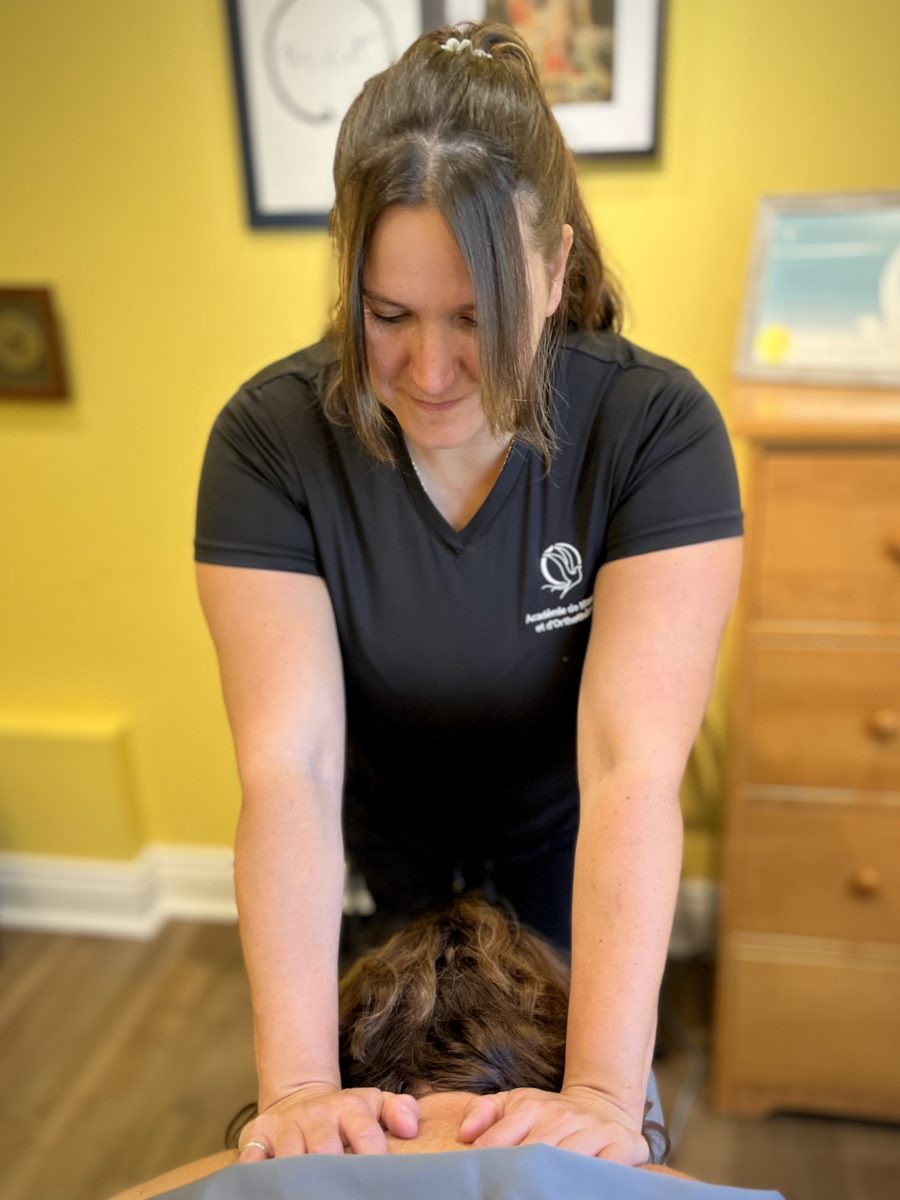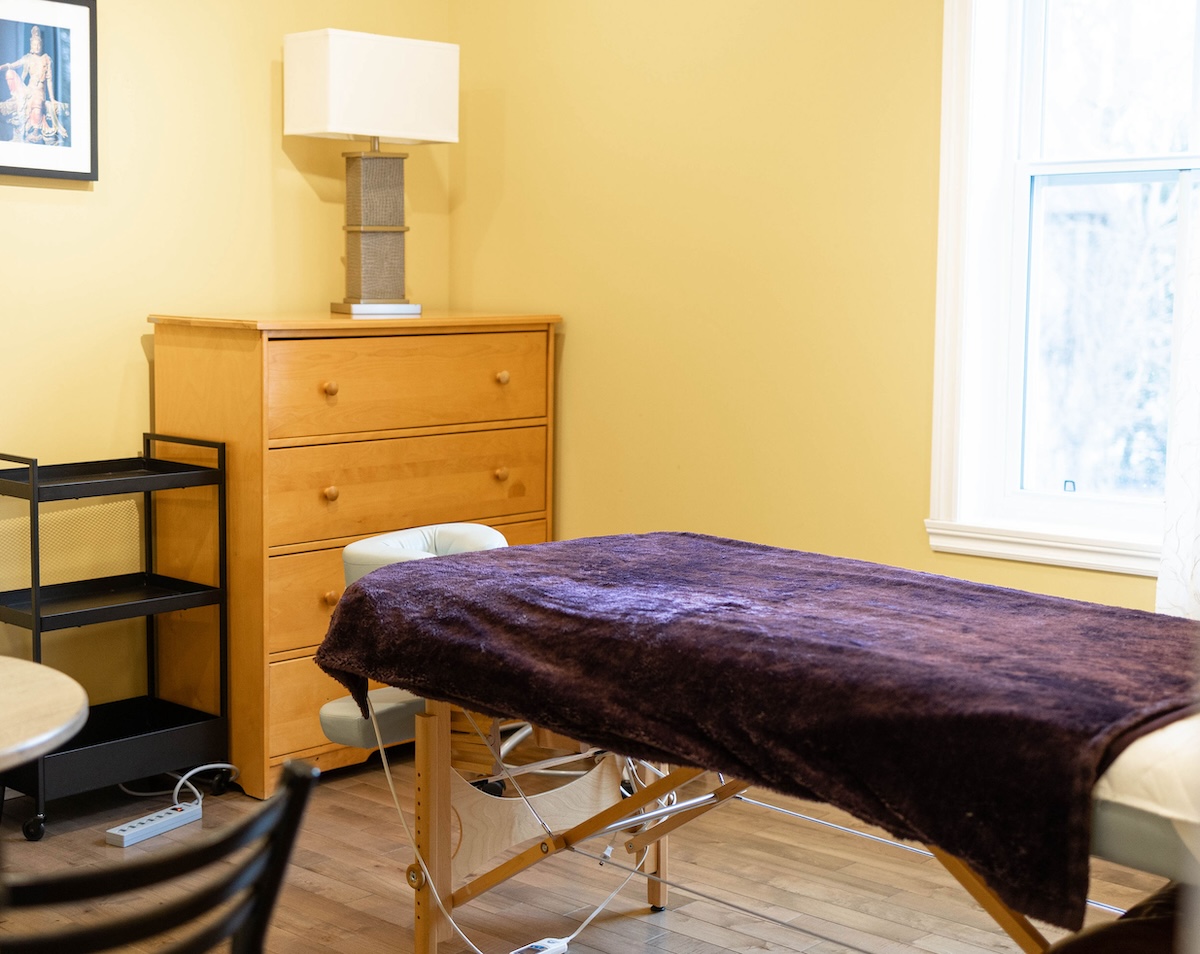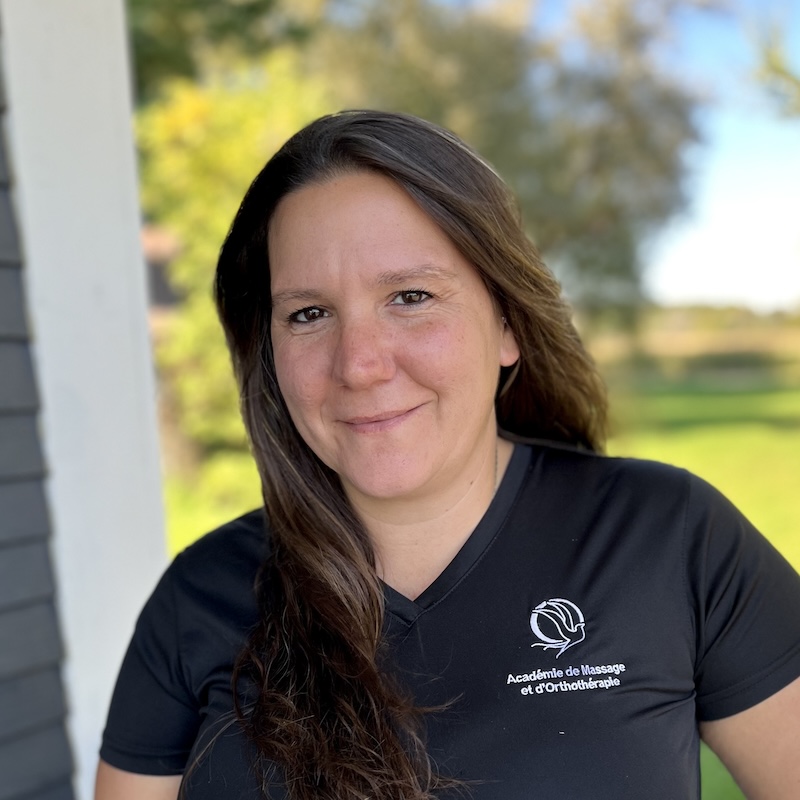massage
About Melanie
About Massage & Orthotherapy
Massage is the practice of manipulating the muscles, connective tissues, tendons, and ligaments of the body using hands, fingers, or sometimes devices. It is often performed to promote relaxation, reduce stress, relieve tension, alleviate pain, and improve circulation. There are many different types of massage, such as:
- Swedish massage: A gentle form that involves long, flowing strokes, kneading, and circular movements to relax muscles and improve circulation.
- Deep tissue massage: Uses more pressure to target deeper layers of muscle and connective tissue, often to help with chronic pain and tightness.
- Therapeutic Massage, A healing practice that uses targeted techniques to relieve tension, reduce pain, and promote overall well-being.
- Myofacial Release: Involves gentle, sustained pressure on the connective tissue (fascia) to relieve pain, improve mobility, and release tension.
- Isometric exercises: The contracting of muscles without changing their length or moving joints, enhancing strength and stability through static holds.
Massage can be used for relaxation or therapeutic purposes, helping with conditions like stress, muscle soreness, anxiety, or poor circulation.
Orthotherapy is a therapeutic practice that focuses on correcting and improving the body’s musculoskeletal system. It combines elements of massage therapy, physical rehabilitation, and postural correction to relieve pain, enhance mobility, and restore balance in the body.
Orthotherapy aims to:
- Realign the musculoskeletal system: Through various techniques, orthotherapists work to restore proper alignment and function in the muscles, bones, and joints.
- Reduce pain and discomfort: The treatment can help alleviate chronic pain, muscle tension, and discomfort related to poor posture, injuries, or overuse.
- Improve posture: One key goal is to correct imbalances in posture that may cause pain or dysfunction over time.
- Enhance mobility and flexibility: Orthotherapy helps restore range of motion and flexibility, often used for rehabilitation after an injury or surgery.
- Promote long-term healing: The focus is on both immediate relief and long-term health by addressing the underlying causes of discomfort, not just the symptoms.
Techniques used in orthotherapy can include deep tissue massage, stretching exercises, and corrective movements. It is often used to treat conditions such as back pain, neck pain, joint issues, sports injuries, and postural imbalances.
THE BENEFITS OF massage



Overall, massage is a holistic approach to promoting both physical and emotional well-being.
CONDITIONS TREATED WITH Massage
Massage offers a wide range of physical, mental, and emotional benefits, making it a popular therapeutic practice. Some of the key benefits of massage include:
Massage helps lower stress hormones (such as cortisol) and boosts the production of feel-good chemicals like serotonin and dopamine, promoting relaxation and an overall sense of well-being.
Whether it’s chronic pain from conditions like arthritis or muscle soreness from overuse, massage can help alleviate pain by reducing muscle tension, improving blood flow, and stimulating endorphin release.
Massage enhances blood circulation, which helps supply more oxygen and nutrients to tissues, promotes cell regeneration, and supports faster recovery from injuries.
Regular massage helps relieve tightness in muscles, improve flexibility, and enhance range of motion. This can be especially helpful for athletes or individuals with physically demanding jobs.
By addressing muscle imbalances and tension, massage can help improve posture. Over time, better posture can reduce chronic pain, especially in the back, neck, and shoulders.
Studies suggest that massage can improve immune function by increasing the activity of natural killer cells, which play a crucial role in defending the body from illness.
Massage helps reduce mental fatigue, increase concentration, and improve mental clarity by promoting relaxation and reducing stress.
Massage therapy has been shown to help lower anxiety levels and reduce symptoms of depression by promoting relaxation, improving sleep quality, and fostering emotional well-being.
By reducing stress and muscle tension, massage can lead to improved sleep quality, making it beneficial for people with insomnia or those who struggle with getting restful sleep.
Massage encourages lymphatic drainage, helping the body eliminate toxins and waste more efficiently. This is particularly helpful for people looking to detoxify their systems.
Massage can increase blood flow to the skin, improving its tone, texture, and overall appearance. The oils or lotions used during massage can also help moisturize the skin.
Athletes often use massage to prevent injuries by keeping muscles flexible and in good condition. It is also helpful in speeding up recovery after injuries, reducing inflammation, and promoting healing.
Stretching and manipulation of muscles during massage can help improve joint flexibility, making movements easier and reducing the risk of injuries.
Contact Melanie
Available at Jai Ma Wellness Center on Mondays (day and evening) and Thursdays (day and evening).

About Melanie
About Massage & Orthotherapy
Massage is the practice of manipulating the muscles, connective tissues, tendons, and ligaments of the body using hands, fingers, or sometimes devices. It is often performed to promote relaxation, reduce stress, relieve tension, alleviate pain, and improve circulation. There are many different types of massage, such as:
- Swedish massage: A gentle form that involves long, flowing strokes, kneading, and circular movements to relax muscles and improve circulation.
- Deep tissue massage: Uses more pressure to target deeper layers of muscle and connective tissue, often to help with chronic pain and tightness.
- Therapeutic Massage, A healing practice that uses targeted techniques to relieve tension, reduce pain, and promote overall well-being.
- Myofacial Release: Involves gentle, sustained pressure on the connective tissue (fascia) to relieve pain, improve mobility, and release tension.
- Isometric exercises: The contracting of muscles without changing their length or moving joints, enhancing strength and stability through static holds
Massage can be used for relaxation or therapeutic purposes, helping with conditions like stress, muscle soreness, anxiety, or poor circulation.
Orthotherapy is a therapeutic practice that focuses on correcting and improving the body’s musculoskeletal system. It combines elements of massage therapy, physical rehabilitation, and postural correction to relieve pain, enhance mobility, and restore balance in the body.
Orthotherapy aims to:
- Realign the musculoskeletal system: Through various techniques, orthotherapists work to restore proper alignment and function in the muscles, bones, and joints.
- Reduce pain and discomfort: The treatment can help alleviate chronic pain, muscle tension, and discomfort related to poor posture, injuries, or overuse.
- Improve posture: One key goal is to correct imbalances in posture that may cause pain or dysfunction over time.
- Enhance mobility and flexibility: Orthotherapy helps restore range of motion and flexibility, often used for rehabilitation after an injury or surgery.
- Promote long-term healing: The focus is on both immediate relief and long-term health by addressing the underlying causes of discomfort, not just the symptoms.
Techniques used in orthotherapy can include deep tissue massage, stretching exercises, and corrective movements. It is often used to treat conditions such as back pain, neck pain, joint issues, sports injuries, and postural imbalances.
THE BENEFITS OF massage

Overall, massage is a holistic approach to promoting both physical and emotional well-being.


CONDITIONS TREATED WITH Massage
Massage offers a wide range of physical, mental, and emotional benefits, making it a popular therapeutic practice. Some of the key benefits of massage include:
Massage therapy has been shown to help lower anxiety levels and reduce symptoms of depression by promoting relaxation, improving sleep quality, and fostering emotional well-being.
By addressing muscle imbalances and tension, massage can help improve posture. Over time, better posture can reduce chronic pain, especially in the back, neck, and shoulders.
By reducing stress and muscle tension, massage can lead to improved sleep quality, making it beneficial for people with insomnia or those who struggle with getting restful sleep.
Stretching and manipulation of muscles during massage can help improve joint flexibility, making movements easier and reducing the risk of injuries.
Studies suggest that massage can improve immune function by increasing the activity of natural killer cells, which play a crucial role in defending the body from illness.
Massage encourages lymphatic drainage, helping the body eliminate toxins and waste more efficiently. This is particularly helpful for people looking to detoxify their systems.
Massage helps reduce mental fatigue, increase concentration, and improve mental clarity by promoting relaxation and reducing stress.
Whether it’s chronic pain from conditions like arthritis or muscle soreness from overuse, massage can help alleviate pain by reducing muscle tension, improving blood flow, and stimulating endorphin release.
Massage enhances blood circulation, which helps supply more oxygen and nutrients to tissues, promotes cell regeneration, and supports faster recovery from injuries.
Massage can increase blood flow to the skin, improving its tone, texture, and overall appearance. The oils or lotions used during massage can also help moisturize the skin.
Athletes often use massage to prevent injuries by keeping muscles flexible and in good condition. It is also helpful in speeding up recovery after injuries, reducing inflammation, and promoting healing.
Regular massage helps relieve tightness in muscles, improve flexibility, and enhance range of motion. This can be especially helpful for athletes or individuals with physically demanding jobs.
Massage helps lower stress hormones (such as cortisol) and boosts the production of feel-good chemicals like serotonin and dopamine, promoting relaxation and an overall sense of well-being.
Contact Melanie
Available at Jai Ma Wellness Center on Mondays (day and evening) and Thursdays (day and evening).

About Melanie
About Massage & Orthotherapy
Massage is the practice of manipulating the muscles, connective tissues, tendons, and ligaments of the body using hands, fingers, or sometimes devices. It is often performed to promote relaxation, reduce stress, relieve tension, alleviate pain, and improve circulation. There are many different types of massage, such as:
- Swedish massage: A gentle form that involves long, flowing strokes, kneading, and circular movements to relax muscles and improve circulation.
- Deep tissue massage: Uses more pressure to target deeper layers of muscle and connective tissue, often to help with chronic pain and tightness.
- Therapeutic Massage, A healing practice that uses targeted techniques to relieve tension, reduce pain, and promote overall well-being.
- Myofacial Release: Involves gentle, sustained pressure on the connective tissue (fascia) to relieve pain, improve mobility, and release tension.
- Isometric exercises: The contracting of muscles without changing their length or moving joints, enhancing strength and stability through static holds.
Massage can be used for relaxation or therapeutic purposes, helping with conditions like stress, muscle soreness, anxiety, or poor circulation.
Orthotherapy is a therapeutic practice that focuses on correcting and improving the body’s musculoskeletal system. It combines elements of massage therapy, physical rehabilitation, and postural correction to relieve pain, enhance mobility, and restore balance in the body.
Orthotherapy aims to:
- Realign the musculoskeletal system: Through various techniques, orthotherapists work to restore proper alignment and function in the muscles, bones, and joints.
- Reduce pain and discomfort: The treatment can help alleviate chronic pain, muscle tension, and discomfort related to poor posture, injuries, or overuse.
- Improve posture: One key goal is to correct imbalances in posture that may cause pain or dysfunction over time.
- Enhance mobility and flexibility: Orthotherapy helps restore range of motion and flexibility, often used for rehabilitation after an injury or surgery.
- Promote long-term healing: The focus is on both immediate relief and long-term health by addressing the underlying causes of discomfort, not just the symptoms.
Techniques used in orthotherapy can include deep tissue massage, stretching exercises, and corrective movements. It is often used to treat conditions such as back pain, neck pain, joint issues, sports injuries, and postural imbalances.
THE BENEFITS OF massage

Overall, massage is a holistic approach to promoting both physical and emotional well-being.


CONDITIONS TREATED WITH Massage
Massage offers a wide range of physical, mental, and emotional benefits, making it a popular therapeutic practice. Some of the key benefits of massage include:
Massage therapy has been shown to help lower anxiety levels and reduce symptoms of depression by promoting relaxation, improving sleep quality, and fostering emotional well-being.
By addressing muscle imbalances and tension, massage can help improve posture. Over time, better posture can reduce chronic pain, especially in the back, neck, and shoulders.
By reducing stress and muscle tension, massage can lead to improved sleep quality, making it beneficial for people with insomnia or those who struggle with getting restful sleep.
Stretching and manipulation of muscles during massage can help improve joint flexibility, making movements easier and reducing the risk of injuries.
Studies suggest that massage can improve immune function by increasing the activity of natural killer cells, which play a crucial role in defending the body from illness.
Massage encourages lymphatic drainage, helping the body eliminate toxins and waste more efficiently. This is particularly helpful for people looking to detoxify their systems.
Massage helps reduce mental fatigue, increase concentration, and improve mental clarity by promoting relaxation and reducing stress.
Whether it’s chronic pain from conditions like arthritis or muscle soreness from overuse, massage can help alleviate pain by reducing muscle tension, improving blood flow, and stimulating endorphin release.
Massage enhances blood circulation, which helps supply more oxygen and nutrients to tissues, promotes cell regeneration, and supports faster recovery from injuries.
Massage can increase blood flow to the skin, improving its tone, texture, and overall appearance. The oils or lotions used during massage can also help moisturize the skin.
Athletes often use massage to prevent injuries by keeping muscles flexible and in good condition. It is also helpful in speeding up recovery after injuries, reducing inflammation, and promoting healing.
Regular massage helps relieve tightness in muscles, improve flexibility, and enhance range of motion. This can be especially helpful for athletes or individuals with physically demanding jobs.
Massage helps lower stress hormones (such as cortisol) and boosts the production of feel-good chemicals like serotonin and dopamine, promoting relaxation and an overall sense of well-being.
Contact Melanie
Available at Jai Ma Wellness Center on Mondays (day and evening) and Thursdays (day and evening).
